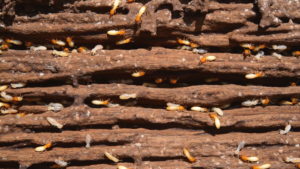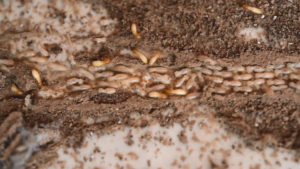Feeding Habits & Behaviours of Termites.
 Cellulose is the basic food requirement for all termites and it is found in all types of plant-based materials. The cellulose is digested by bacteria in the gut of species in the family Termitidae. Most termite species eat grass and other ground growth and have an important role in maintaining soil fertility.The plant tissues on which termites feed contain very little protein and therefore little nitrogen but nitrogen is not contained in the protozoa bacteria. It is vital for them to conserve nitrogen and this is accomplished by consuming the excess dead or diseased colony members. Gut bacteria is also used by some termites to regulate the nitrogen in the atmosphere.
Cellulose is the basic food requirement for all termites and it is found in all types of plant-based materials. The cellulose is digested by bacteria in the gut of species in the family Termitidae. Most termite species eat grass and other ground growth and have an important role in maintaining soil fertility.The plant tissues on which termites feed contain very little protein and therefore little nitrogen but nitrogen is not contained in the protozoa bacteria. It is vital for them to conserve nitrogen and this is accomplished by consuming the excess dead or diseased colony members. Gut bacteria is also used by some termites to regulate the nitrogen in the atmosphere.
Does Soil Benefit From Termite Mounds & Galleries
When soil particles rich in nutrients i.e. calcium, magnesium and potassium are washed into the soil from eroding termite mounds this then becomes advantageous for plant growth. Soil structure, water entry and storage in soil is improved by termite galleries thus enabling water runoff and reduces soil erosion.
Natural Enemies
Ants are the most significant natural enemy of the termite but not the only predator. Lizards, snakes, frogs, insect eating (Insectivorous) and eating food of every kind (Omnivorous) birds, dragonflies especially and other predatory insects.
Echidna Tachyglossus aculeatus use their strong, long clawed feet to attack mounds and subterranean galleries to access the termite workers and soldiers which form an important part of the Echidna’s diet.
Timber in it’s early stage of decay by wood-rotting fungi attracts other termite species while other species of timbers are termite resistant but none are entirely “Termite Proof”. Materials damaged by termites but not able to digest are plastics, rubber, metal and mortar and the damage occurs when they come across those materials while searching for food. For some termites they use subterranean galleries or covered runways to forage for food. These galleries extend from the central nest to food sources above or below ground and the gallery system of a single colony may utilize as far as one hectare to forage for food. Individual galleries can extend up to 50 meters in length but the northern termite Mastotermes darwiniensis have individual galleries extending as far as 100 – 200 meters. All termites except the grass-eating species which forage in the open, remain in the closed system of galleries where no light can penetrate. The light is of no use to the worker and soldier as they are blind and have only a thin covering which gives them a very low resistance to drying out. The only exception is during swarming flights, repairs or new formations.
The closed system gives termites two advantages. Firstly protection from natural enemies, secondly a degree of protection from temperature, extreme humidity and keeps the nest a constant 36 degrees.
Five families of termites occur in Australia and all five are found in Queensland



